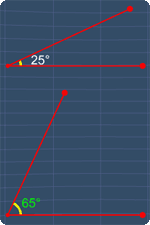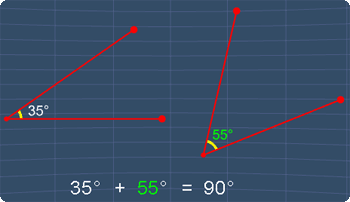Complementary Angles
Lesson Objective
In this lesson, we will learn about complementary angles.
About This Lesson
In this lesson, we will learn:
- What are complementary angles
- See some examples on identifying them
The study tips below will give you a short summary on this.
The math video below will explain in depth about this. Furthermore, it will show some examples so that you can understand this lesson better.

Study Tips
Tip #1
When we add two angles and get 90°, we can say that these angles are complementary angles. See an example below:

The math video below will explain more on this.
Math Video
Lesson Video
Sponsored Links
Math Video Transcript
00:00:03.220
In this lesson, we will learn about comp. angles.
00:00:08.110
Let's take a look at these two angles.
00:00:12.130
Notice that, when we add these two angles, we get 90 degrees.
00:00:18.200
Seeing this, we can say that these two angles are comp. angles.
00:00:24.210
Now, when we rotate this arm, these two angles must add to 90 degrees, to remain as comp. angles.
00:00:39.070
Adding 15 degrees with 75 degrees, gives 90 degrees.
00:00:51.020
Adding 67 degrees with 23 degrees, gives 90 degrees.
00:00:58.030
Now, let's see some examples.
00:01:02.140
Are these comp. angles?
00:01:06.030
To find out, we just need to add 12 degrees with 78 degrees. This gives 90 degrees.
00:01:15.220
Hence, these are angles that are complementary.
00:01:21.110
Next example, these two angles are comp. angles. Find x.
00:01:28.240
We know that, when we add these 2 angles, we must get 90 degrees.
00:01:36.240
Hence, we can find 'x', by subtracting 90 degrees, with 73 degrees.
00:01:44.210
Therefore, ‘x’ will be equals to 17 degrees.
00:01:50.190
That is all for this lesson.
Practice Questions & More
Multiple Choice Questions (MCQ)
Now, let's try some MCQ questions to understand this lesson better.
You can start by going through the series of questions on complementary angles or pick your choice of question below.
Site-Search and Q&A Library
Please feel free to visit the Q&A Library. You can read the Q&As listed in any of the available categories such as Algebra, Graphs, Exponents and more. Also, you can submit math question, share or give comments there.


